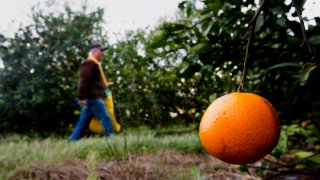The orange production has been on a quarter century slide due to citrus greening, a bacteria that can cause massive fruit drops and eventually kill the citrus tree
Published January 19, 2022 •

An orange hangs from a tree as Tim Brown, owner of Brown’s Grove Citrus and Produce, walks though the company’s grove in Sarasota, Florida, U.S., on Friday, Jan. 3, 2014.
Florida is on pace to produce the smallest crop of oranges in more than 75 years, according to a forecast released this month.
The Sunshine State is on pace to produce 44.5 million 90-pound boxes of oranges during the current season, according to a forecast released last week by the U.S. Department of Agriculture. That is a 1.5 million box reduction from the previous forecast in December.
If the current forecast holds true through the rest of the citrus growing season, it will be the smallest orange crop since the 1944-1945 season when the state produced 42.3 million boxes of oranges. The citrus growing season in Florida lasts from fall into late spring. Comparing that to the 1997-1998 harvest season, when that production number was previously up to 244 million boxes of oranges.
With that small a crop, California will surpass Florida in orange production for the first time in recent years.
The processors who are making the orange juice in result need to buy more fruit, which leads to higher costs needed to manufacture the orange juice. According to NBC News, the national average for a bottle of orange juice is up 15 cents from 2020.
“The disappointment of another decline in the forecast is hard to overstate. But so too is the determination of Florida’s citrus growers who remain focused on delivering great-tasting and high-quality fruit while – simultaneously – seeking new solutions to citrus greening,” said Shelley Rossetter, assistant director of global marketing at the Florida Department of Citrus, in a statement.
Florida's orange production has been on a quarter century slide due to citrus greening, a bacteria that can cause massive fruit drops and eventually kill citrus trees, as well as another disease which can cause the leaves and fruit of citrus trees to drop prematurely and create unappealing lesions on the fruit.
According to the U.S. Department of Agriculture, there is no current cure for citrus greening, which is known to devastate millions of crops in the United States and across the globe. It is spread by a disease-infected insect. Infected trees in result produce fruits that are green, misshapen and bitter, and unsuitable for sale.
The January forecast for grapefruit remained unchanged from the previous month at 4.1 million boxes.
Copyright AP - Associated Press
No comments:
Post a Comment